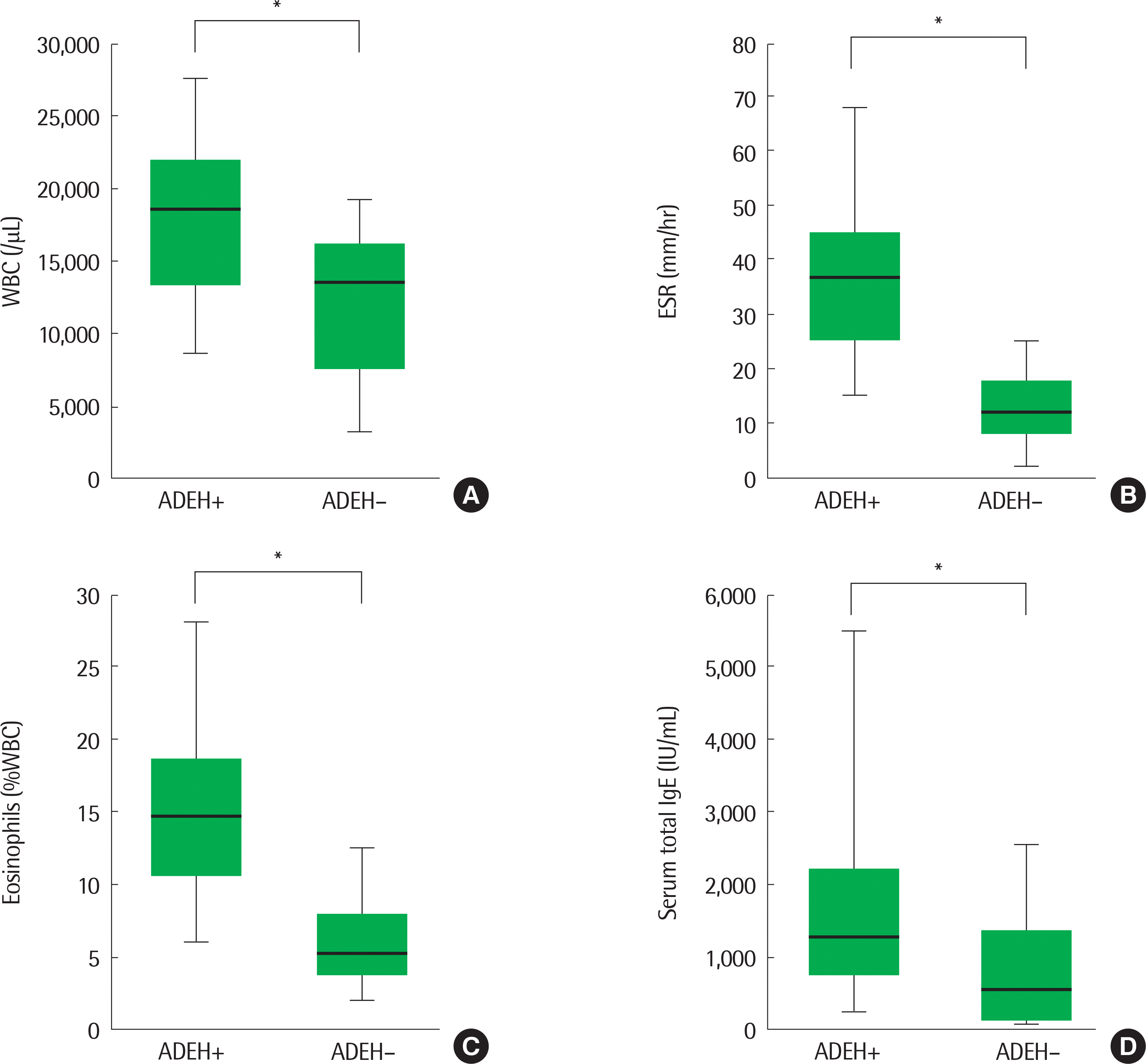Abstract
Purpose
This study evaluated the clinical characteristics and risk factors associated with atopic dermatitis patients complicated by eczema herpeticum.
Methods
This study included 45 patients under the age of 18 with atopic dermatitis complicated by eczema herpeticum in the disease group (ADEH+), and 50 patients under the age of 18 with atopic dermatitis without any episode of eczema herpeticum in the control group (ADEH–). We retrospectively reviewed the clinical features, treatment and prognosis of the 2 groups.
Results
In this study, eczema herpeticum occurred in 2.7% of the AD patients. No significant difference in percentage of boys or mean age was found between the ADEH+ and ADEH– groups. In the ADEH+ group, eczema herpeticum occurred more frequently in the head and neck. Severe atopic dermatitis, recurrent impetigo, IgE–mediated atopic dermatitis and food allergy were identified as the risk factors of eczema herpeticum. The mean white blood cell count, erythrocyte sedimentation rate, percent of eosinophils and total serum IgE were higher in the ADEH+ group than in the ADEH– group. More than 2 recurrences were confirmed in 12 patients (26.7%).
REFERENCES
1. Ahn K. The prevalence of atopic dermatitis in Korean children. Allergy Asthma Immunol Res. 2016; 8:1–2.

2. Lee SI, Kim J, Han Y, Ahn K. A proposal: Atopic Dermatitis Organizer (ADO) guideline for children. Asia Pac Allergy. 2011; 1:53–63.

3. Schneider L, Tilles S, Lio P, Boguniewicz M, Beck L, LeBovidge J, et al. Atopic dermatitis: a practice parameter update 2012. J Allergy Clin Immunol. 2013; 131:295–9.e1-27.
4. Spergel JM. Epidemiology of atopic dermatitis and atopic march in children. Immunol Allergy Clin North Am. 2010; 30:269–80.

6. Boguniewicz M, Leung DY. Atopic dermatitis: a disease of altered skin barrier and immune dysregulation. Immunol Rev. 2011; 242:233–46.

7. Malik K, Heitmiller KD, Czarnowicki T. An update on the pathophysiology of atopic dermatitis. Dermatol Clin. 2017; 35:317–26.

9. Wollenberg A, Wetzel S, Burgdorf WH, Haas J. Viral infections in atopic dermatitis: pathogenic aspects and clinical management. J Allergy Clin Immunol. 2003; 112:667–74.

10. Park HS, You CE, Son SJ, Park MY, Whang KU. A clinicopathological study of Kaposi's varicelliform eruption. Korean J Dermatol. 2005; 43:1220–7.
11. Liaw FY, Huang CF, Hsueh JT, Chiang CP. Eczema herpeticum: a medical emergency. Can Fam Physician. 2012; 58:1358–61.
13. Beck LA, Boguniewicz M, Hata T, Schneider LC, Hanifin J, Gallo R, et al. Phenotype of atopic dermatitis subjects with a history of eczema herpeticum. J Allergy Clin Immunol. 2009; 124:260–9. 269.e1-7.

14. Hanifin JM, Rajka G. Diagnostic features of atopic dermatitis. Acta Derm Venereol (Stockh). 1980; 92(Suppl):44–7.
15. Swart RN, Vermeer BJ, van Der Meer JW, Enschedé FA, Versteeg J. Treatment of eczema herpeticum with acyclovir. Arch Dermatol. 1983; 119:13–6.

16. Lin Y, Zhu M, Su Z. The pursuit of balance: an overview of covariate-adaptive randomization techniques in clinical trials. Contemp Clin Trials. 2015; 45(Pt A):21–5.

17. Rullo VE, Segato A, Kirsh A, Sole D. Severity scoring of atopic dermatitis: a comparison of two scoring systems. Allergol Immunopathol (Madr). 2008; 36:205–11.

18. Zheng T, Yu J, Oh MH, Zhu Z. The atopic march: progression from atopic dermatitis to allergic rhinitis and asthma. Allergy Asthma Immunol Res. 2011; 3:67–73.

19. Peng WM, Jenneck C, Bussmann C, Bogdanow M, Hart J, Leung DY, et al. Risk factors of atopic dermatitis patients for eczema herpeticum. J Invest Dermatol. 2007; 127:1261–3.

20. Bin L, Kim BE, Brauweiler A, Goleva E, Streib J, Ji Y, et al. Staphylococcus aureus alpha-toxin modulates skin host response to viral infection. J Allergy Clin Immunol. 2012; 130:683–91.e2.
21. Gao PS, Rafaels NM, Mu D, Hand T, Murray T, Boguniewicz M, et al. Genetic variants in thymic stromal lymphopoietin are associated with atopic dermatitis and eczema herpeticum. J Allergy Clin Immunol. 2010; 125:1403–7.e4.

22. Wollenberg A, Zoch C, Wetzel S, Plewig G, Przybilla B. Predisposing factors and clinical features of eczema herpeticum: a retrospective analysis of 100 cases. J Am Acad Dermatol. 2003; 49:198–205.

Fig. 1.
Comparison of laboratory data between ADEH+ and ADEH– groups. White blood cell (WBC) count (A), erythrocyte sedimentation rate (ESR) (B), percent of eosinophils (C), and serum total IgE level (D). AD, atopic dermatitis; ADEH+, AD patients with one or more episodes of AD complicated by eczema herpeticum (ADEH); ADEH–, AD patients without any episode of ADEH. ∗ P<0.05.

Table 1.
Difference of clinical characteristics between ADEH+ and ADEH- groups
Table 2.
Difference of sensitization between ADEH+ and ADEH– groups
Table 3.
Clinical manifestations and prognosis of ADEH+ group (n=45)




 PDF
PDF ePub
ePub Citation
Citation Print
Print


 XML Download
XML Download